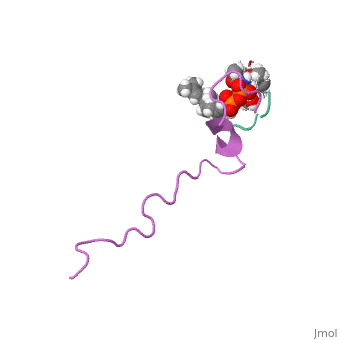1wco
From Proteopedia
(Difference between revisions)
| Line 3: | Line 3: | ||
== Structural highlights == | == Structural highlights == | ||
[[1wco]] is a 2 chain structure with sequence from [http://en.wikipedia.org/wiki/Lactococcus_lactis Lactococcus lactis] and [http://en.wikipedia.org/wiki/Monarthropalpus_flavus Monarthropalpus flavus]. This structure supersedes the now removed PDB entry [http://oca.weizmann.ac.il/oca-bin/send-pdb?obs=1&id=1uzt 1uzt]. Full experimental information is available from [http://oca.weizmann.ac.il/oca-bin/ocashort?id=1WCO OCA]. <br> | [[1wco]] is a 2 chain structure with sequence from [http://en.wikipedia.org/wiki/Lactococcus_lactis Lactococcus lactis] and [http://en.wikipedia.org/wiki/Monarthropalpus_flavus Monarthropalpus flavus]. This structure supersedes the now removed PDB entry [http://oca.weizmann.ac.il/oca-bin/send-pdb?obs=1&id=1uzt 1uzt]. Full experimental information is available from [http://oca.weizmann.ac.il/oca-bin/ocashort?id=1WCO OCA]. <br> | ||
| - | <b>Related:</b> [[1aj1|1aj1]], [[1mqx|1mqx]], [[1mqy|1mqy]], [[1mqz|1mqz]], [[1qow|1qow]], [[1w9n|1w9n]], [[2dde|2dde]], [[2ktn|2ktn]], [[2kto|2kto]]<br> | + | <b>[[Ligand|Ligands:]]</b> <scene name='pdbligand=FPP:FARNESYL+DIPHOSPHATE'>FPP</scene>, <scene name='pdbligand=NAG:N-ACETYL-D-GLUCOSAMINE'>NAG</scene><br> |
| + | <b>[[Non-Standard_Residue|NonStd Res:]]</b> <scene name='pdbligand=DAL:D-ALANINE'>DAL</scene>, <scene name='pdbligand=DBB:D-ALPHA-AMINOBUTYRIC+ACID'>DBB</scene>, <scene name='pdbligand=DBU:(2Z)-2-AMINOBUT-2-ENOIC+ACID'>DBU</scene>, <scene name='pdbligand=DHA:2-AMINO-ACRYLIC+ACID'>DHA</scene>, <scene name='pdbligand=FGA:GAMMA-D-GLUTAMIC+ACID'>FGA</scene>, <scene name='pdbligand=MUB:N-ACETYLMURAMIC+ACID'>MUB</scene><br> | ||
| + | <b>[[Related_structure|Related:]]</b> [[1aj1|1aj1]], [[1mqx|1mqx]], [[1mqy|1mqy]], [[1mqz|1mqz]], [[1qow|1qow]], [[1w9n|1w9n]], [[2dde|2dde]], [[2ktn|2ktn]], [[2kto|2kto]]<br> | ||
<b>Activity:</b> <span class='plainlinks'>[http://en.wikipedia.org/wiki/Glucokinase Glucokinase], with EC number [http://www.brenda-enzymes.info/php/result_flat.php4?ecno=2.7.1.2 2.7.1.2] </span><br> | <b>Activity:</b> <span class='plainlinks'>[http://en.wikipedia.org/wiki/Glucokinase Glucokinase], with EC number [http://www.brenda-enzymes.info/php/result_flat.php4?ecno=2.7.1.2 2.7.1.2] </span><br> | ||
| + | <b>Resources:</b> <span class='plainlinks'>[http://oca.weizmann.ac.il/oca-docs/fgij/fg.htm?mol=1wco FirstGlance], [http://oca.weizmann.ac.il/oca-bin/ocaids?id=1wco OCA], [http://www.rcsb.org/pdb/explore.do?structureId=1wco RCSB], [http://www.ebi.ac.uk/pdbsum/1wco PDBsum]</span><br> | ||
== Publication Abstract from PubMed == | == Publication Abstract from PubMed == | ||
The emerging antibiotics-resistance problem has underlined the urgent need for novel antimicrobial agents. Lantibiotics (lanthionine-containing antibiotics) are promising candidates to alleviate this problem. Nisin, a member of this family, has a unique pore-forming activity against bacteria. It binds to lipid II, the essential precursor of cell wall synthesis. As a result, the membrane permeabilization activity of nisin is increased by three orders of magnitude. Here we report the solution structure of the complex of nisin and lipid II. The structure shows a novel lipid II-binding motif in which the pyrophosphate moiety of lipid II is primarily coordinated by the N-terminal backbone amides of nisin via intermolecular hydrogen bonds. This cage structure provides a rationale for the conservation of the lanthionine rings among several lipid II-binding lantibiotics. The structure of the pyrophosphate cage offers a template for structure-based design of novel antibiotics. | The emerging antibiotics-resistance problem has underlined the urgent need for novel antimicrobial agents. Lantibiotics (lanthionine-containing antibiotics) are promising candidates to alleviate this problem. Nisin, a member of this family, has a unique pore-forming activity against bacteria. It binds to lipid II, the essential precursor of cell wall synthesis. As a result, the membrane permeabilization activity of nisin is increased by three orders of magnitude. Here we report the solution structure of the complex of nisin and lipid II. The structure shows a novel lipid II-binding motif in which the pyrophosphate moiety of lipid II is primarily coordinated by the N-terminal backbone amides of nisin via intermolecular hydrogen bonds. This cage structure provides a rationale for the conservation of the lanthionine rings among several lipid II-binding lantibiotics. The structure of the pyrophosphate cage offers a template for structure-based design of novel antibiotics. | ||
Revision as of 10:02, 30 April 2014
The solution structure of the nisin-lipid II complex
| |||||||||||
Categories: Lactococcus lactis | Monarthropalpus flavus | Bonvin, A M.J J. | Breukink, E. | Hsu, S T.D. | Kaptein, R. | Kruijff, B De. | Lutters, M A.G. | Nuland, N A.J Van. | Tischenko, E. | Antimicrobial | Bacteriocin | Food preservative | Lantibiotic | Peptide-antibiotic complex | Pore formation | Pyrophosphate cage | Thioester

